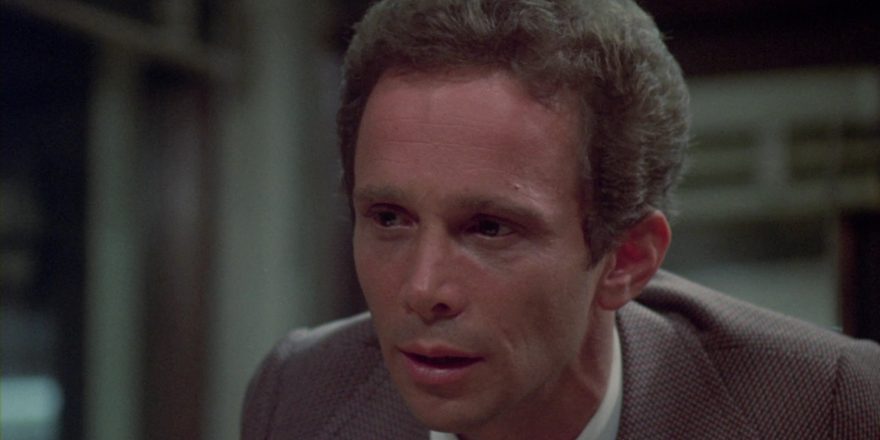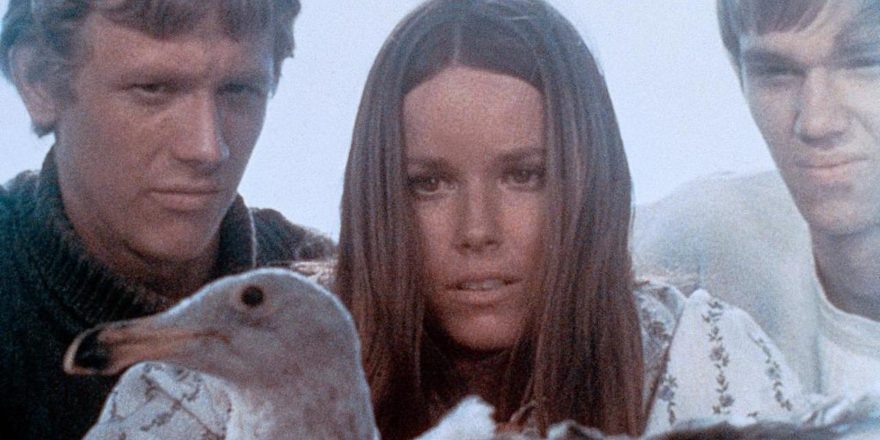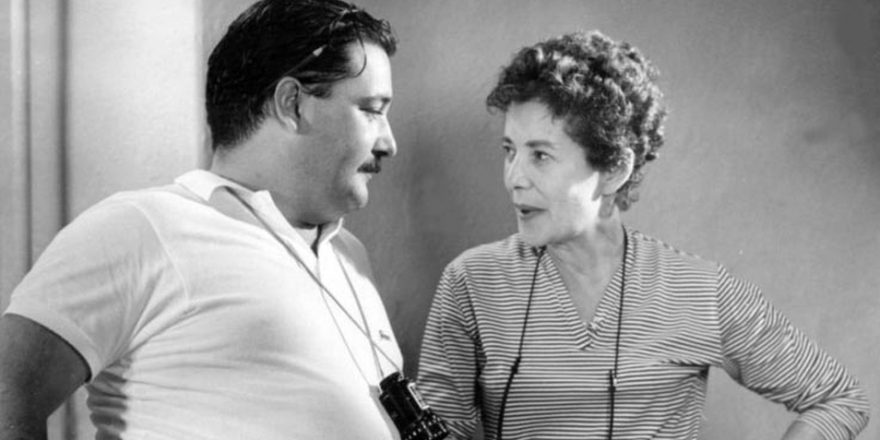Frank Perry’s 1974 Man on a Swing may not be regarded as one of the filmmaker’s best films, but even the lesser work of a great director is usually worth watching. A maverick who made brilliant, risk-taking pictures too caustic and disturbing for mainstream consumption, Perry is rarely given the recognition bestowed upon his indie contemporaries like Altman and Cassavetes, even though the best of his work – David and Lisa, The Swimmer, Last Summer, Diary of a Mad Housewife, Play It As It Lays, and yes, Mommie Dearest – easily rates with their best. Perry started out making consistently inventive indie films with screenplays written by his wife, Eleanor (their collaboration ending, upon their divorce, with Diary of a Mad Housewife), often concerned with psychologically disturbed characters that act out against the establishment or institutions that oppress them. Man on a Swing, then, is an unappreciated, almost forgotten film by a neglected director, which makes its pleasures all the more sweet.
Although Man on a Swing declares at the beginning that it’s based on events that actually occurred, the film might also be regarded as a loose remake or reworking of Bryan Forbes’ superior Séance on a Wet Afternoon (1964), both films taking as their subject clairvoyants that stage crimes in order to help police solve the cases with their putative telepathic abilities, thereby making them stars in the psychic community. In Séance, Kim Stanley plays Myra Savage, an unhinged medium that convinces her milquetoast husband, Bill (Richard Attenborough), to kidnap the daughter of a wealthy businessman. She then pays the distraught parents a visit, providing them with clues that only she could know about through her proximity to the “borrowed” child. In Man on a Swing, Joel Grey plays Franklin Wills, a psychic who contacts the local police chief, Lee Tucker (Cliff Robertson), with information about the murder of a young woman whose body was found strangled in a car in a parking lot, details that are known only to the police. The plot revolves around whether or not Franklin is, in fact, clairvoyant, or a fraud that is somehow complicit in the murder in order to make people believe he’s telepathic. In both cases, there’s a certain ambiguity about whether or not these conniving clairvoyants actually have any true psychic ability, or whether their elaborate schemes and attempts to become famous at all costs are more indicative of psychological disturbance, or even pure madness.
Although it will soon turn into a chilling neo-noir, Man on a Swing starts out as a pretty standard, almost banal police procedural. After some nifty opening credits superimposed over the back window of a speeding police car, Tucker and a fellow police officer interview a number of pertinent people about the girl’s murder, their accounts of the events of her disappearance and the discovery of the body used as voiceover for a series of flashbacks. Tucker, a normal, down-to-earth, police chief, drinks a six pack with a reporter while watching a slideshow of photographs of the crime scene, then interviews a young suspect, Richie Tom Keating, who was previously arrested for attempting to rape a woman at knifepoint. Tucker returns home to his pregnant wife, Janet (the underappreciated Dorothy Tristan), establishing his domestic situation as a vulnerable site that will later be exploited by Wills. It’s a standard noir set-up, with the wife and child (or future child) of the police officer – think Fritz Lang’s The Big Heat – targeted and victimized by the criminal being investigated.
The set-up of the film continues conventionally enough, with Tucker visiting the sister and the parents of the victim (they show him Super 8 home movies of their daughter) and interviewing her jock ex-boyfriend (Gil Gerard). We also learn more details about the case – that there was no sexual assault, and that a tampon was found beside the body – information that Tucker shares with his wife. Finally, about 22 minutes into the film, Tucker gets a call from Franklin, who claims to have had visions of the murder scene. He says he knows that she was “in the cycle of the month,” and that a pair of her prescription glasses was found in the car, neither detail having been released to the press. (Franklin claims he doesn’t watch the news or read newspapers anyway.) Tucker tells his right hand man, Officer Younger (Peter Masterson), to “get him in here now.” He asks Franklin if he knows where the police station is, to which he replies, “Officer Younger. I’m clairvoyant.”
When Joel Grey enters the picture, The Man on a Swing finally takes off. We’re introduced to Franklin Wills with a close-up of his white dress shoes coming down the stairs, panning up to reveal a short, immaculately dressed, boyish young man in a suit and tie. When he sits down opposite Tucker to be interviewed, there’s an immediate tension set up between the masculine, no-nonsense police chief and the somewhat effeminate, ephemeral clairvoyant. We later find out that Franklin is married and has a young son, but he is signified as homosexual in a number of conventional ways – his fastidiousness and primness, his lithe physicality, his air of the dancer and the vaudevillian. The classic nuclear-family-in-the-making represented by Tucker and his pregnant wife is paralleled with the clairvoyant and his wife and child, a kind of ghost family that doesn’t quite appear to be real. (Franklin’s wife is passive and obedient, almost as if he has her hypnotized.) The heteronormative family, headed by the cop, the representative of law and order, is threatened and subverted by this cracked-mirror image of it, a corrupt and possibly criminal simulacrum that challenges the dominant order. Interestingly, Séance on a Wet Afternoon presents a similar formula. The kidnappers, Myra and Bill, had a son who died in childbirth that Myra, as a medium, now believes is her spirit guide to contact souls on the other side. The perfect, normal family whose daughter is kidnapped is mirrored by this psychic family whose son is a mere ghost, and when they “borrow” the little girl (as Myra puts it), their fragmented family is made whole again, albeit for sinister purposes. In both films, it’s a psychologically complex scenario that plays on our fears of the disruption of the traditional family unit.
The rest of Man on a Swing is a cat-and-mouse scenario between Tucker and Franklin, the two polar opposite men, the former on the side of the masculine, the natural, the rational, and the rule of law, the latter on the side of the feminine, the supernatural, the metaphysical, and, potentially, the criminally insane. In an odd twist, it’s revealed that Franklin works at a factory, unexpectedly aligning him with the working class, which makes sense when we realize that he sees his psychic career as a way of extricating himself from his dreary, anonymous existence and achieving celebrity. Joel Grey, in his first big screen role since winning an Oscar for Cabaret, throughout the film uses his body like the dancer that he is, elegantly breezing through rooms, abruptly transfiguring his physicality when he goes into trances, throwing himself against walls, or leaping onto tables. He’s fascinating to watch, but equally good is Robertson, whose very face, as he silently scrutinizes Franklin to figure out if he’s authentic or a fake, is a masterclass in reactive screen acting.
In the centerpiece of the film, Tucker takes Franklin on an excursion to retrace the steps of the victim on the day she was murdered. Tucker meets him at his home where he sees him with his son, dressed identically, almost like a ventriloquist’s dummy. Franklin tells him, “Oh, I hope I haven’t been so good that you think I’m the killer,” almost daring Tucker to suspect him. Donning an immaculate white suit and white shoes for their day out, Franklin takes on first the physicality of the female victim, then he seems possessed by the murderer, attempting to strangle Tucker as if in a trance. (The sequence is covered in a series of telephoto shots, creating space for Grey’s terpsichorean performance.) Franklin ends up on a child’s swing set, embodying a child as Tucker looks on like a stern father.
In the following scene, an hour later, Franklin, still in his white suit, visits Tucker’s home to find Tucker’s wife spray-painting a crib in the garage. Having already heard all about the odd clairvoyant from her husband, Janet is creeped out by the little man, who tells her, without being asked, that she is not pregnant with twins (which she admits she had been worrying about), and that the baby is a girl, even though such predictions are rare for him. When Janet sneezes, he produces a white linen handkerchief and offers it to her, which she declines, causing him to insist, backing her up against the garage wall. When he loses his cool and yells at her to take it, she does so reluctantly and fearfully. “You look exactly like I pictured you,” he says before leaving her a nervous wreck. It’s a crucial little scene that suggests Franklin may indeed have some psychic ability, and that also shows a seriously malevolent side of him, a perverse character directly threatening the stable, ordinary family. In Séance on a Wet Afternoon, a somewhat similar scene (but in reverse) has the mother of the kidnapped daughter visiting the psychic for a séance, which takes place in the room adjacent to the one in which the drugged daughter is being concealed. In both cases, the creepy clairvoyant is psychologically manipulating the mother.
After Franklin is administered a test of his psychic abilities, the film segues into true neo-noir territory, combined with elements of horror (signified by Lalo Schifrin’s eerie score), particularly the “home invasion” scenario, an allegory for the threat to the nuclear family by external forces, often a projection of repression or homosexual panic within. (Think any film of the genre, from Straw Dogs to Funny Games.) Someone – presumably Franklin – begins to make phone calls in the middle of the night, and slides a Christmas card (in July) through the mail slot. Tucker begins to unravel, and barges into Franklin’s home, threatening to kill him.
In Séance on a Wet Afternoon, the police chief and his colleague finally get Myra Savage to confess by convincing her to have a séance with them in which she can prove once and for all her psychic abilities. Instead, she goes into a trance and inadvertently confesses to the crime, which is deeply connected to the loss of her own baby in childbirth. Man on a Swing, which is based on a true story, isn’t so neatly resolved. Tucker tries to enact a similar trap by having Franklin go into a trance in front of two psychiatrists, but instead of confessing to an involvement in the murder, he comes out of it only to suggest Tucker get a newspaper to do a story on him and his psychic powers to solve the crime. When Tucker declines, Franklin goes into a final trance in which he has another vision – a female with back pain that they will know about in the very near future. The next day, a 12-year-old girl is found dead in a nearby park with a broken back, strangled and with no sexual molestation. A witness ties the original suspect, Richie Tom Keating, to the scene of the abduction, and when Tucker questions him, he confesses that he knows Franklin Wills but “we hardly ever talked.” It’s suggested that he was hypnotized by Franklin to commit the murders for him so that he could become famous for predicting the crimes.
The film ends with Tucker visiting Franklin in his home one last time, asking him if he can tell him why anyone would want to murder a little girl. Franklin deflects the question, asking instead if he can get him into Keating’s trial. As Tucker leaves, Franklin says he’d be surprised if Keating ever tells him anything different about the murders, and then adds, “Lee, why don’t you call me after the baby’s born” – a little girl, according to Franklin, like the murder victim. He says he’s sure the girl will be healthy, but it might be a good idea for them to stay in touch. Disturbed and disgusted, Tucker exits, and we are left with a close-up of Franklin’s face and his creepy, enigmatic smile. A postscript tells us Keating was convicted of the first murder, but the second one remains unsolved. As in most Frank Perry films, from The Swimmer to Last Summer to Diary of a Mad Housewife to Play It As It Lays, the character that is mad or driven mad remains so at the end of the picture, with no tidy narrative resolution or reassuring happy ending. It’s a disturbing universe that Perry presents, and one that has never been easily digested by audiences accustomed to pacifying Hollywood fantasies.






